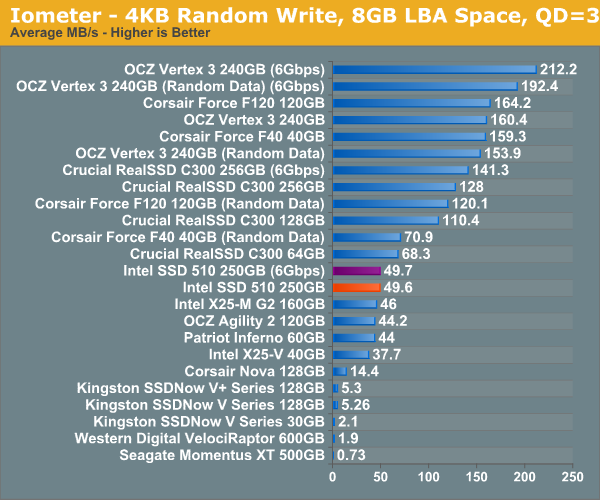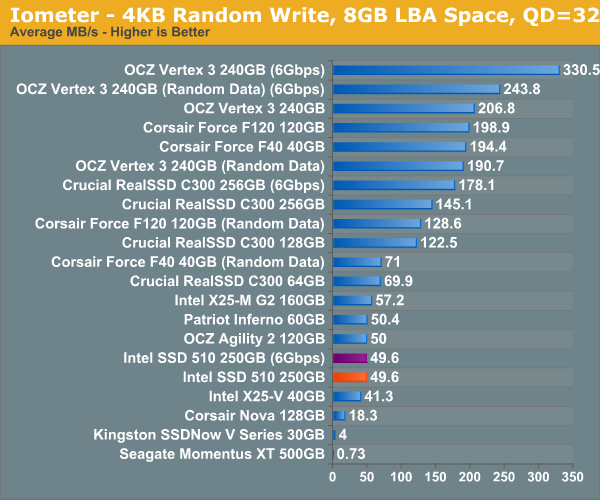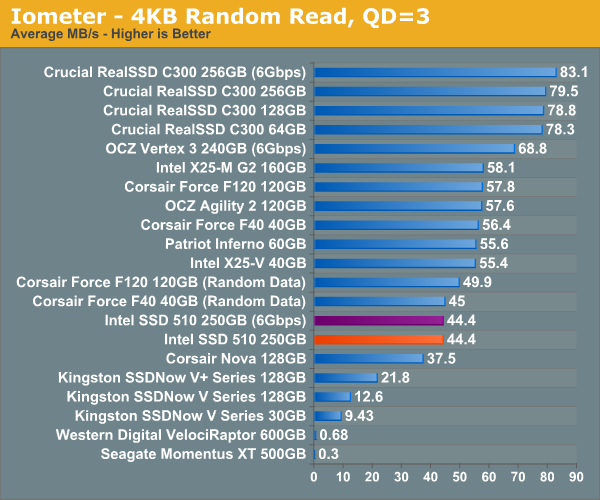The Intel SSD 510 Review
by Anand Lal Shimpi on March 2, 2011 1:23 AM EST- Posted in
- IT Computing
- Storage
- SSDs
- Intel
- Intel SSD 510
Random Read/Write Speed
The four corners of SSD performance are as follows: random read, random write, sequential read and sequential write speed. Random accesses are generally small in size, while sequential accesses tend to be larger and thus we have the four Iometer tests we use in all of our reviews.
Our first test writes 4KB in a completely random pattern over an 8GB space of the drive to simulate the sort of random access that you'd see on an OS drive (even this is more stressful than a normal desktop user would see). I perform three concurrent IOs and run the test for 3 minutes. The results reported are in average MB/s over the entire time. We use both standard pseudo randomly generated data for each write as well as fully random data to show you both the maximum and minimum performance offered by SandForce based drives in these tests. The average performance of SF drives will likely be somewhere in between the two values for each drive you see in the graphs. For an understanding of why this matters, read our original SandForce article.

It's a bit unfortunate for Intel that we happen to start our performance analysis with a 4KB random write test in Iometer. The 510's random write performance is only marginally better than the X25-M G2 at 49.7MB/s. The RealSSD C300 is faster, not to mention the SF-1200 based Corsair Force F120 and the SF-2200 based OCZ Vertex 3.
Although not depicted here, max write latency is significantly reduced compared to the X25-M G2. While the G2 would occasionally hit a ~900ms write operation, the 510 keeps the worst case latency to below 400ms. The Vertex 3 by comparison has a max write latency of anywhere from 60ms - 350ms depending on the type of data being written.
Many of you have asked for random write performance at higher queue depths. What I have below is our 4KB random write test performed at a queue depth of 32 instead of 3. While the vast majority of desktop usage models experience queue depths of 0 - 5, higher depths are possible in heavy I/O (and multi-user) workloads:

While the X25-M G2 scaled with queue depth in our random write test, the 510 does not. It looks like 50MB/s is the absolute highest performance we'll see for constrained 4KB random writes. Note that these numbers are for 4KB aligned transfers, performance actually drops down to ~40MB/s if you perform sector aligned transfers (e.g. performance under Windows XP).

Random read performance is just as disappointing. The X25-M G2 took random read performance seriously but the 510 is less than 20% faster than the Indilinx based Corsair Nova. When I said the Intel SSD 510's random performance is decidedly last-generation, I meant it.










128 Comments
View All Comments
Marlin1975 - Wednesday, March 2, 2011 - link
How about throwing in a AMD SB850 to see how they handle SSD's.AMD has had native SATA6gb longer than intel so like to see how that matchs up. Most only look at CPU and ignore the chipset.
DarkKnight_Y2K - Wednesday, March 2, 2011 - link
+1tech6 - Wednesday, March 2, 2011 - link
So nothing has really changed. There still isn't one "perfect" SSD that does everything well and is proven to be reliable. I guess the disappointment stems from many that were hoping that the new Intel SSDs would tick all those boxes - speed, reliability and price. As usual YMMV - Samsung and Intel is the conservative choice and SF based drives are for those who want maximum performance in random I/O situations.tno - Wednesday, March 2, 2011 - link
This, as always in the tech world, is a numbers and marketing game. Somewhere there is a user who is encoding video and really needs the bleeding edge for that. There is an artist working on large incompressible canvasses in Photoshop. These guys need this drive. They have a small Sandforce doing OS duties but they need a fast non -Sandforce drive for data. All those numbers mean squat without perspective and that's what's the text of Anandtech articles bring.So maybe for the consumer that is tech savvy enough to know they want an SSD but not enough to have read all that has been published with regards SSD drives they need a simple primer. Maybe a web app. Do you use you computer with VMs? Do you use it with games? Is your computer a netbook? I'm certain there is a way to ask a few questions and come up with a sensible suggestion for what drive is right for which user.
That would only work with a more comprehensive field of tested drives. Other posters are right, there is little to no way of knowing which is the best 40GB drive. So I volunteer myself to help. Anand, I am a soon to be new father that would love to work from home if for no other reason than daycare costs nearly as much as what I get paid as a paramedic. Send me a system, every SSD on the market and a small stipend and I will test anything and everything solid state.
Gigantopithecus - Wednesday, March 2, 2011 - link
...with poor product differentiation. With Intel's adoption of the same controller others are using, SSDs become that much less interesting. I realize firmware and QC differences still exist, but without hard numbers (aside from the French site's), and given that major snafus can hit any maker at any time, it seems like the only real consideration is ye ole customer service. I've dealt with OCZ's 'support' department twice and that was enough for me. Intel and Crucial have always treated me right, so considering real world performance differences more or less don't exist anymore, they'll be getting my SSD $s.LeeKay - Wednesday, March 2, 2011 - link
have had 100% Faliure and i have had 5 drives all failed.iwod - Wednesday, March 2, 2011 - link
I have been asking the question for a long time. Why an Toshiba SSD manage to beat Sandforce in some real world usage. And finally we got an answer.Given all SSD latency are roughly equal or the same.
Seq Read Write is EXTREMELY Important in Everyday usage. IT IS THE SINGLE MOST Important factor that gives you most improvement in SSD Real World usage benchmarks.
Random Write reaches the top with 50 MB/s. And while we would want further reduction in Write latency, but with the increase of Ram / Cache onbroad with SSD. This should not be an issue.
Random Read results shows we have still some head room to grow.
With further tweaking Intel may be able to squeeze out even more performance our of it.
tno - Thursday, March 3, 2011 - link
I think I missed something, while Seq Read Write is obviously the big number that makes the marketing materials, in terms of user experience (ooh, buzzword) the Random Reads are where lies the money, and as Anand said in the article, no modern OS stresses this enough to make the lower numbers a significant limitation.High sequential reading and writing is only going to be felt by those that are moving large files around within an already fast environment where a mechanical disk drive would be a bottle neck (encoding files locally for instance). And while for those users Seq Read Write might be considered "THE SINGLE MOST important factor" it wouldn't be for, say, the person that wants to add some oopmh to a dual-core laptop of otherwise mediocre specifications.
Certainly, aside from playing around with transferring files, my drives have probably never approached their max seq speed. As OS drives, they mainly spend their time hunting out small files for the OS to use.
Beenthere - Wednesday, March 2, 2011 - link
These SSDs aren't ready for prime time just yet IMO. Maybe in another 2-3 years?tno - Thursday, March 3, 2011 - link
What's the hold up? Reliability? Speed?